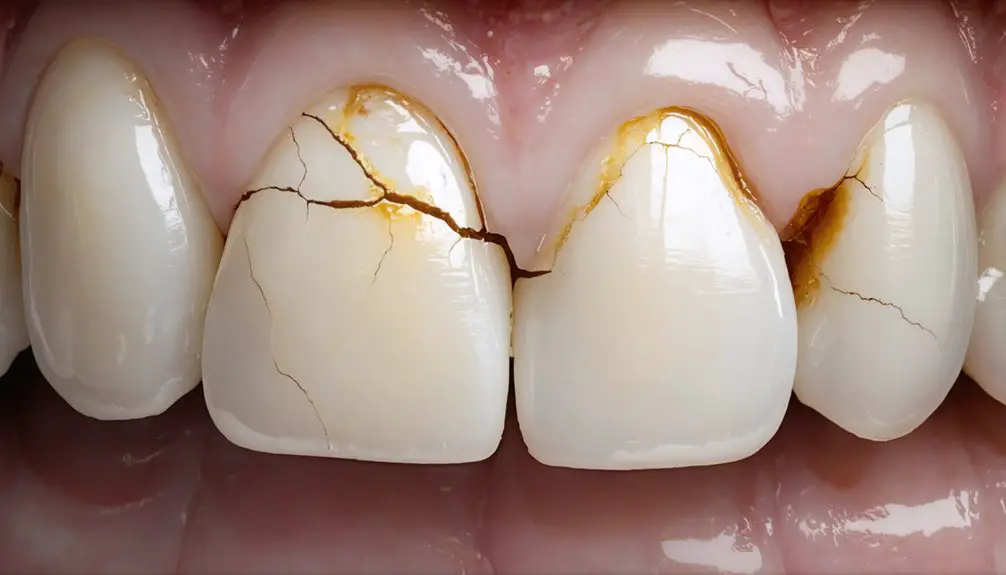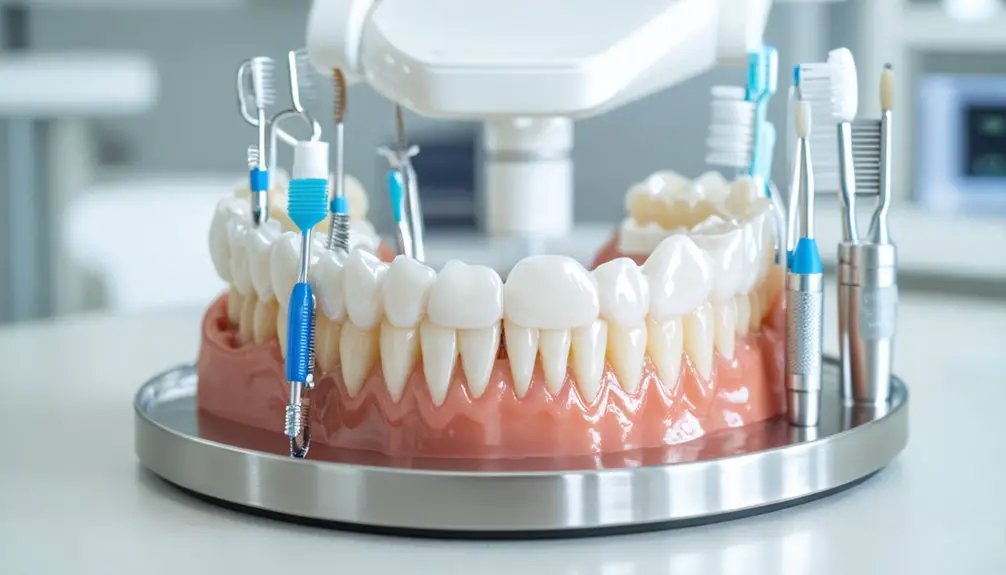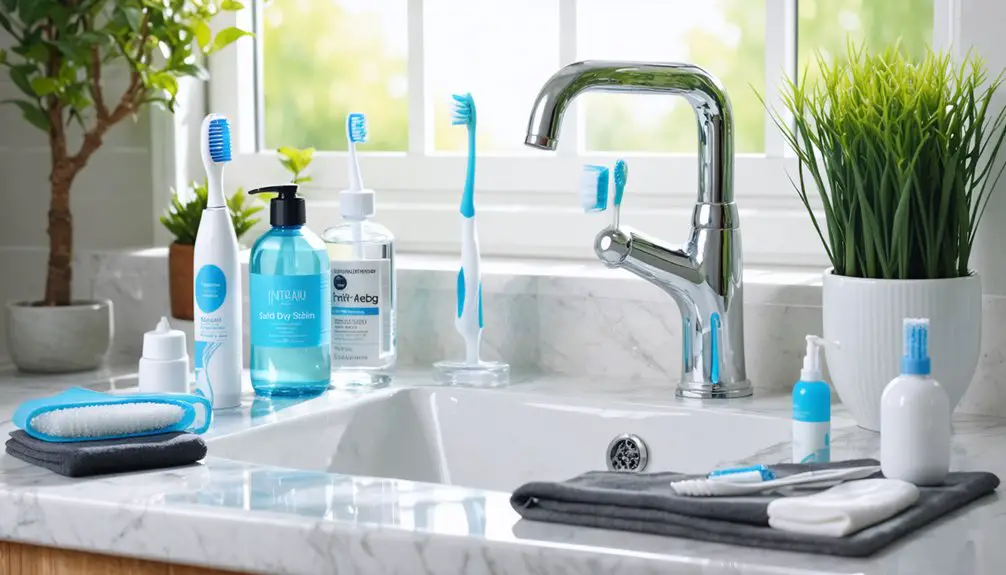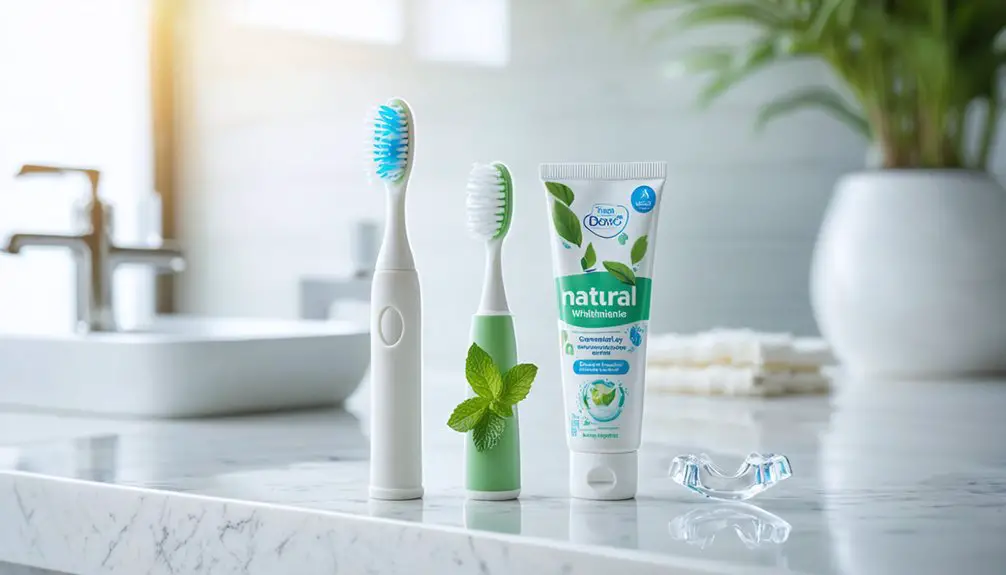Long-term teeth whitening treatments can pose several risks to your dental health. You’ll face potential issues like chronic tooth sensitivity, permanent enamel damage, and uneven coloration if you don’t properly monitor your whitening regimen. While professional treatments offer safer options with protective measures, over-the-counter products may lead to chemical burns, gum irritation, and accelerated enamel erosion. Understanding the proper timing, concentration levels, and protective strategies will help you achieve safer, more effective whitening results.
Key Takeaways
- Prolonged exposure to whitening agents can cause severe tooth sensitivity due to enamel demineralization and exposed dentinal tubules connected to nerve endings.
- Repeated treatments may lead to permanent enamel erosion, resulting in increased tooth translucency and a glass-like appearance.
- Chemical burns and gum tissue inflammation can occur from frequent hydrogen peroxide exposure, especially with improper application methods.
- Continuous whitening treatments can create uneven results due to varying enamel thickness and non-whitening dental work.
- Long-term use of multiple whitening products simultaneously increases risks of overexposure and potential damage to oral tissues.
Understanding Tooth Sensitivity During Whitening
Why do so many people experience discomfort during teeth whitening treatments? The answer lies in how whitening agents interact with your tooth structure.
When you apply bleaching products containing hydrogen peroxide, they cause enamel demineralization, making your teeth more porous. This process exposes the dentinal tubules – microscopic channels that connect to your tooth’s nerve endings.
Teeth whitening agents break down enamel structure, creating tiny openings that expose sensitive nerve pathways beneath the surface.
As these tubules become exposed, you’ll experience tooth sensitivity, particularly when consuming hot, cold, or sweet items. The bleaching gels make your enamel temporarily more permeable, allowing access to the dentin layer where nerves reside. Higher concentrations of whitening agents can lead to increased sensitivity levels.
The deeper these agents penetrate your tooth layers, the more intense the sensitivity becomes. In severe cases, the whitening compounds can reach the tooth’s pulp, causing significant discomfort. While the exact mechanism isn’t completely understood, research shows that peroxide-based whitening agents are primarily responsible for temporary tooth sensitivity.
Permanent Changes to Tooth Enamel
Beyond temporary sensitivity, many patients worry about lasting damage to their teeth from whitening treatments. Research shows that when you use professional whitening agent concentrations under supervision, there’s no significant permanent damage to your enamel.
While temporary softening can occur, your natural enamel remineralization techniques through saliva restore strength quickly. Professional whitening lasts longer than at-home treatments due to controlled application methods.
Being the hardest substance in the human body, tooth enamel provides excellent protection against whitening agents.
- Professional whitening treatments use safe concentrations that protect enamel integrity
- Temporary changes to enamel microstructure are reversible with proper care
- Fluoride treatments help strengthen enamel after whitening procedures
- Your enamel’s translucency and hardness remain intact with supervised treatments
- Natural remineralization occurs through saliva, reversing short-term softening
It’s important to note that while professional treatments are safe, unsupervised or aggressive whitening can risk permanent enamel changes.
Following recommended treatment intervals and professional guidance guarantees your enamel’s long-term health.
Gum Health and Irritation Concerns
Your gum tissue’s health can be greatly compromised during teeth whitening if proper protective measures aren’t taken, especially when bleaching agents make direct contact with sensitive gum areas.
Professional treatments offer superior gum protection through specialized tools like dental dams and retractors, while home treatments require careful application and properly fitted trays to minimize risks. Contact with whitening gels containing hydrogen peroxide concentrations can cause chemical burns and inflammation of gum tissue. Mild side effects typically resolve within a few days with proper post-treatment care and maintenance.
You’ll need to strictly control bleaching agent contact with your gums by following treatment instructions precisely and using protective barriers, whether you’re receiving professional care or using at-home whitening products.
Preventing Gum Tissue Damage
While teeth whitening treatments can effectively brighten your smile, they pose significant risks to gum tissue when not performed properly. Hydrogen peroxide exposure during whitening procedures is a primary cause of chemical burns and tissue inflammation. Professional treatments ensure optimal safety through careful monitoring and expert application.
To protect your gums from chemical exposure during whitening methods, you’ll need to take specific preventive measures. Professional supervision and careful adherence to treatment protocols are crucial for minimizing potential damage.
- Always use dental dams or protective barriers when applying whitening agents
- Choose lower concentration products if you’re prone to sensitivity
- Follow application instructions precisely, avoiding contact with gum tissue
- Verify whitening trays fit properly to prevent gel leakage
- Schedule regular dental check-ups to monitor gum health during treatment
Professional vs. Home Treatment
The effectiveness and safety of teeth whitening treatments vary notably between professional and at-home applications, particularly regarding gum health.
When you choose professional whitening, you’ll benefit from controlled application methods using protective barriers and custom-fitted trays, considerably reducing gum exposure to bleaching agents. While professional treatments use higher concentrations, their shorter treatment duration minimizes tissue irritation. The use of barrier creams during professional treatments provides an extra layer of protection for sensitive gum tissue.
At-home whitening carries greater risks due to improper application and prolonged exposure. You’re more likely to experience gum irritation, chemical burns, or tissue damage from ill-fitting trays and inconsistent product use.
Without professional supervision, you might inadvertently overuse products or miss early signs of gum damage. While home treatments offer convenience, their whitening effectiveness often comes at the cost of increased gum sensitivity and potential long-term tissue complications.
Managing Bleaching Agent Contact
Managing bleaching agent contact requires careful attention to both application methods and protective measures since common whitening compounds can trigger significant gum irritation.
When you’re performing whitening treatments, it’s critical to understand that higher peroxide concentrations directly correlate with increased gum sensitivity and potential tissue damage. A properly fitted tray will help prevent soft tissue exposure and minimize discomfort. You’ll need to carefully monitor exposure time and concentration levels to prevent chemical burns while maintaining effective results.
- Use protective barriers like resin dams or gingival shields during professional treatments
- Apply whitening gel sparingly to prevent seepage onto gum tissue
- Monitor patients with existing gum recession for heightened sensitivity
- Reduce treatment duration if signs of tissue irritation appear
- Consider lower peroxide concentrations (around 10%) for extended treatment plans
The Reality of Translucent Teeth
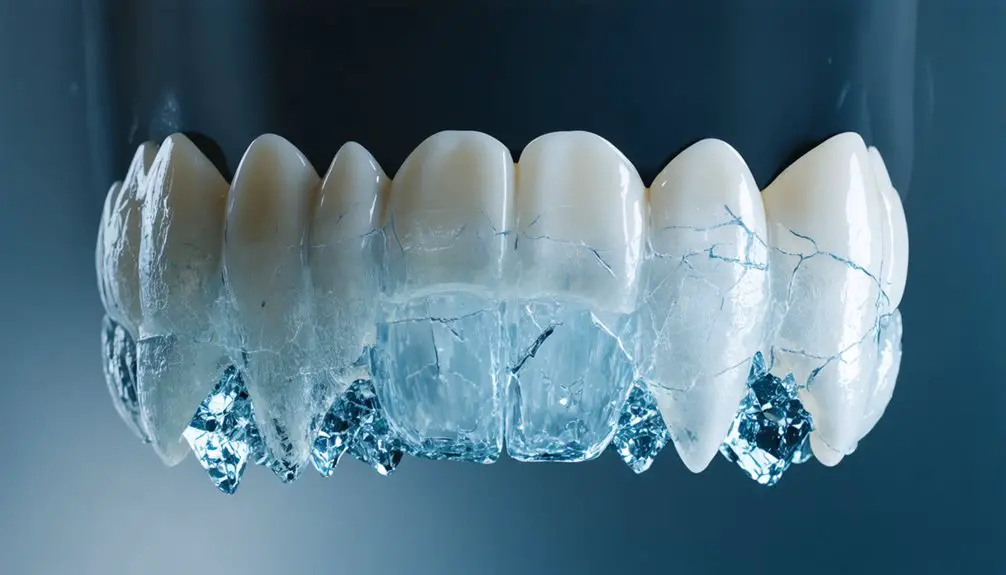
If you’re noticing your teeth becoming increasingly translucent, you’re likely experiencing enamel erosion that can be worsened by aggressive whitening treatments.
Your teeth may develop a glass-like appearance, particularly at the edges, along with heightened sensitivity to temperature and acidic substances due to compromised enamel.
To protect your remaining enamel, you’ll need to modify your whitening routine and adopt protective measures like using sensitive toothpaste and avoiding acidic foods.
Understanding Translucent Appearance Effects
While teeth whitening treatments effectively brighten your smile, they can temporarily alter the appearance of your teeth by creating a translucent effect. This aesthetic concern typically manifests as white patches or streaks, particularly noticeable at the thinner incisal edges of your teeth.
The translucency occurs when whitening gels containing hydrogen peroxide temporarily soften and dehydrate your enamel.
- Whitening-induced translucency is most visible at tooth tips where enamel is naturally thinner
- Temporary white patches and streaks appear due to enamel dehydration during treatment
- Changes are usually reversible as enamel rehydrates and remineralizes
- The bleaching process targets stains in the dentin while temporarily affecting enamel appearance
- Pre-existing conditions like enamel hypoplasia can increase susceptibility to translucent effects
Preventing Further Enamel Loss
The preservation of tooth enamel becomes a primary focus once translucent effects appear from whitening treatments.
You’ll need to implement proper enamel remineralization techniques, including fluoride treatments and careful monitoring of whitening product safety protocols.
To prevent additional enamel loss, you should avoid abrasive whitening toothpastes and adopt gentle brushing methods during treatment periods.
It’s crucial to limit exposure to high-concentration peroxide products, as they can temporarily soften your enamel.
Professional supervision allows for customized treatment plans that consider your unique enamel condition.
You can protect your enamel by using potassium nitrate and fluoride treatments, maintaining proper treatment intervals, and avoiding acidic beverages during whitening periods.
These preventive measures help maintain your enamel’s integrity while achieving desired whitening results.
Uneven Whitening Results Over Time
Understanding uneven whitening patterns begins with recognizing how tooth structure influences bleaching results. Your teeth’s natural enamel thickness and composition directly affect how they’ll respond to whitening treatments.
You’ll notice color variations developing when treatment frequency isn’t properly spaced, as your teeth need time to equalize between sessions.
- Thinner enamel areas whiten faster but may appear blotchy due to increased dentin visibility
- Poorly fitting whitening trays cause uneven gel distribution and inconsistent results
- Dental work like crowns and fillings won’t whiten, creating noticeable color discrepancies
- Natural tooth variations and surface irregularities affect bleaching agent absorption
- Color differences typically stabilize within 3-10 days post-treatment if you allow proper equilibration time
Watch for signs of uneven whitening, especially if you have existing dental work or enamel wear.
Professional supervision helps minimize these risks while achieving ideal results.
Safety Standards and Product Regulations
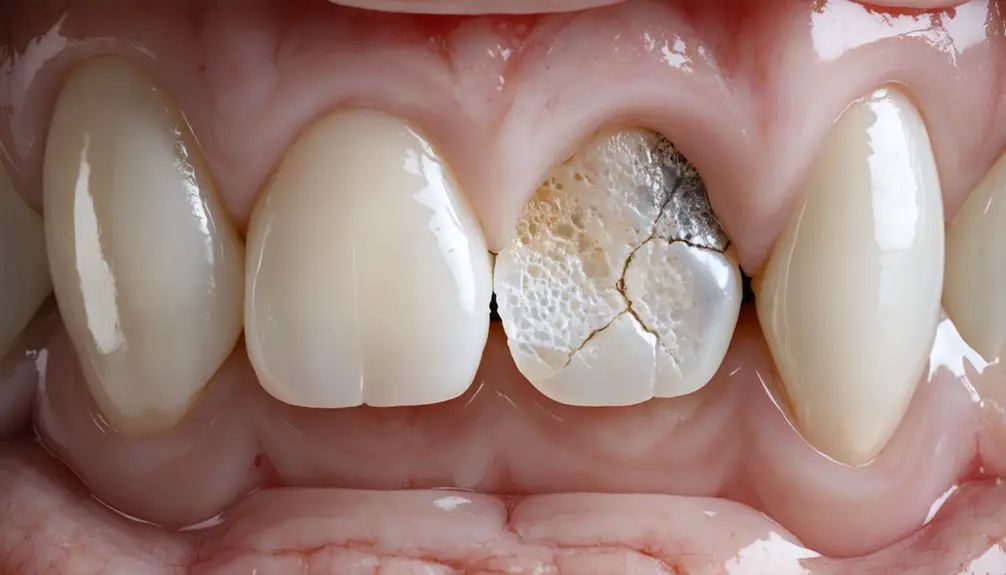
Beyond achieving consistent whitening results, knowing how regulatory bodies oversee teeth whitening products helps you make informed safety decisions.
The FDA classifies whitening products into three categories: medical devices, OTC drugs, and cosmetics, each with specific regulatory compliance requirements.
You’ll find peroxide-based products must meet strict ingredient safety standards, with concentration limits carefully monitored.
While Class I whitening devices can be FDA registered, they’re not FDA approved – an important distinction when evaluating product claims. Look for “FDA registered” status rather than misleading “FDA approved” claims.
To protect your patients, verify that whitening products display accurate ingredient lists and proper safety instructions.
Products with peroxide concentrations above certain thresholds face stricter oversight as OTC drugs, ensuring additional safety measures for professional use.
Professional vs. Over-the-Counter Treatment Risks
When choosing between professional and over-the-counter teeth whitening treatments, you’ll encounter distinct risk profiles that warrant careful consideration.
Professional tooth whitening offers more controlled treatment duration and supervision, reducing risks of sensitivity and gum irritation. However, both methods can potentially affect your dental health, with OTC treatments typically carrying higher risks due to less oversight and standardization.
- Professional treatments use custom-fitted trays and desensitizing agents to minimize discomfort.
- OTC products increase risks of uneven results and enamel damage due to improper application.
- Sensitivity and gum irritation are more common with unsupervised OTC treatment duration.
- Professional supervision helps prevent overuse and monitors adverse reactions.
- Both methods may affect existing dental work differently, leading to color mismatches.
Impact on Existing Dental Work

The presence of existing dental work greatly impacts your teeth whitening outcomes and treatment approach.
Having dental work like crowns or fillings can significantly affect how teeth whitening treatments work and what results you can expect.
While whitening agents won’t damage your fillings, crowns, or veneers, these restorations won’t lighten like your natural teeth. This creates a noticeable mismatch that may require restoration replacement to achieve uniform coloring.
If you’ve recently had dental work, you’ll need to wait 7-14 days before starting any whitening treatment. This allows dental adhesives to fully stabilize and reduces risks to your new restorations.
Your whitening frequency should be carefully monitored, as aggressive bleaching can affect enamel structure and surface integrity.
For best results, complete any desired whitening before getting permanent restorations like porcelain crowns, since these materials won’t respond to bleaching agents.
Managing Long-Term Side Effects
Managing long-term side effects of teeth whitening requires careful attention to sensitivity levels and treatment protocols. Your long-term strategies should focus on using lower concentrations of whitening agents and shorter application times to minimize discomfort while maintaining effectiveness.
If you’re experiencing persistent sensitivity, you’ll need to implement proper sensitivity management techniques and consider switching to products with carbamide peroxide instead of hydrogen peroxide.
- Monitor sensitivity levels regularly and adjust treatment frequency accordingly
- Use protective barriers to prevent soft tissue irritation during applications
- Schedule regular dental check-ups to assess enamel integrity and pulpal health
- Consider alternative whitening products if sensitivity persists beyond 24 hours
- Implement treatment breaks to allow tooth remineralization and tissue recovery
These preventive measures will help maintain ideal dental health while achieving desired whitening results without compromising long-term oral wellness.
Prevention Strategies for Dental Health
You’ll need to establish a balanced whitening schedule that aligns with your dental visits to monitor enamel health and address any emerging sensitivity issues.
Professional guidance guarantees you’re using appropriate concentrations and application methods that won’t compromise your tooth structure over time.
Regular dental checkups combined with preventive treatments like fluoride applications and sealants can greatly offset the risks associated with long-term whitening use.
Balanced Whitening Treatment Schedule
Creating an effective teeth whitening schedule requires careful consideration of treatment intervals and recovery periods to protect dental health while achieving desired results.
You’ll need to make whitening interval adjustments based on your specific dental conditions and lifestyle factors, while implementing proper enamel recovery techniques between treatments.
- Professional treatments should be spaced 6-12 months apart to allow sufficient enamel restoration.
- At-home whitening kits can be used every 2-6 weeks, depending on product strength.
- Daily whitening toothpaste helps maintain results between major treatments.
- Natural whitening methods should be limited to once weekly due to abrasion risks.
- Extend intervals if you experience sensitivity or gum irritation.
Monitor your teeth’s response to treatments and adjust frequency accordingly.
Remember that proper spacing between sessions prevents enamel damage while maintaining lasting results.
Safe Application Methods
To maintain dental health during whitening treatments, proper application methods serve as critical safeguards against potential complications.
You’ll need to start with appropriate whitening product selection, prioritizing ADA-approved options and consulting dental professionals for customized treatment plans. Using custom-fitted trays guarantees precise gel application while minimizing gum exposure and sensitivity risks.
You should follow manufacturer guidelines strictly, opting for shorter, multiple sessions rather than extended treatments.
If you’re working with patients who’ve dental restorations, you’ll need professional assessment before proceeding, as these areas require special consideration. Incorporate desensitizing agents and fluoride treatments into your protocol, and monitor for any adverse reactions.
Remember to avoid simultaneous use of multiple whitening products, as this can lead to overexposure and increased sensitivity.
Professional Guidance Benefits
Professional guidance during teeth whitening treatments provides essential safeguards against potential complications while maximizing long-term results.
Through custom whitening protocols and thorough patient education, dental professionals can assess your oral health status and develop targeted treatment plans that protect your teeth and restorations. You’ll receive expert monitoring throughout the process to prevent enamel damage and manage sensitivity issues that may arise.
- Regular dental check-ups enable early detection of potential complications
- Personalized instruction on post-whitening care and maintenance
- Professional evaluation of existing dental work to prevent damage
- Tailored adjustments to treatment frequency and concentration
- Expert guidance on safe at-home touch-up treatments between visits
These preventive measures guarantee you achieve ideal whitening results while maintaining your oral health integrity over time.
Frequently Asked Questions
Can Teeth Whitening Treatments Affect Fertility or Pregnancy Outcomes?
You’ll want to avoid teeth whitening during pregnancy since there’s limited research on safety. Whitening chemicals could potentially reach your fetus, and pregnancy hormones already increase your oral sensitivity.
Do Whitening Treatments Change the Effectiveness of Medications Taken Orally?
You don’t need to worry about whitening treatment safety affecting your oral medications. There’s no scientific evidence that teeth whitening interferes with how your medications work in your body.
How Do Teeth Whitening Products Interact With Metal Braces?
You’ll experience uneven whitening with braces since brackets block coverage. Consider delaying treatments until after removal to avoid increased braces sensitivity and achieve more uniform whitening timing and results.
Can Teeth Whitening Cause Headaches or Affect Sinus Pressure?
You may experience temporary discomfort, as whitening ingredients can cause tooth sensitivity that radiates to your head and facial area. While sinus pressure sensations occur, they’re typically brief and manageable.
Does Smoking Between Whitening Treatments Reduce Their Effectiveness?
Yes, smoking considerably reduces whitening duration and effectiveness. You’ll experience rapid staining, diminished results, and weakened enamel structure. The smoking impact requires more frequent treatments to maintain desired whiteness.
References
- https://www.cornerstonedentistryvan.com/long-term-risks-frequent-teeth-whitening/
- https://www.dentistryofwestbend.com/teeth-whitening-risks-and-side-effects/
- https://pmc.ncbi.nlm.nih.gov/articles/PMC4058574/
- https://narrewarrendentalcare.com.au/risks-of-teeth-whitening-what-you-need-to-know-before-getting-started/
- https://www.giodentalsl.com/are-teeth-whitening-treatments-causing-long-term-side-effects/
- https://harrisburgsmilesdental.com/why-does-teeth-whitening-cause-sensitivity-understanding-the-basics/
- https://tooth-doctor.com/severe-tooth-sensitivity-after-teeth-whitening/
- https://familydentistchandler.com/how-to-avoid-teeth-sensitivity-after-whitening/
- https://www.scottgreenhalghdds.com/blog/10-tips-for-dealing-with-sensitivity-after-teeth-whitening
- https://www.wauwatosadentists.com/does-teeth-whitening-cause-tooth-sensitivity/
